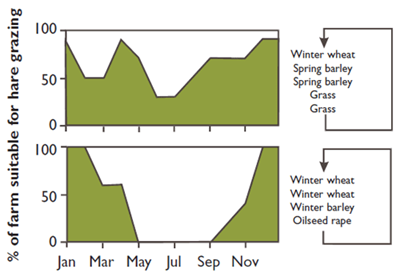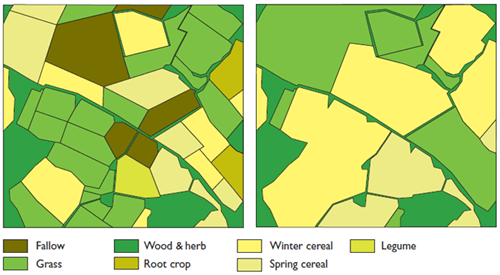The mid-Victorian countryside probably provided the best habitat for hares. The ‘patchwork quilt’ landscape consisted of a mix of cereals, root crops, and grass with livestock. The small fields allowed hares to shift between them, grazing different crops and grass when conditions were right. In summer long cereals provided cover for adults and leverets and the ley grass and pastures good grazing conditions. In winter the root crops and winter cereals provided cover and forage.
Today’s farmland is less mixed and more polarised, with arable lands dominating the east and southern counties, livestock rearing and dairying the west. Modern arable systems make life difficult for hares in three ways.
- There is no continuity of grazing. In the absence of grass, oilseed rape and winter cereals provide enough food in winter, but by early summer these crops are too mature to allow grazing and hares then have to eke out grazing along field boundaries, tracks and roadsides.

Food supply for hares on a traditional post-war ley farm compared with a modern one.
Under the ley rotation the sequence of cereals was followed by grass, which produced a
crop pattern providing forage for hares year round. A modern rotation with break
crops instead of grass provides no grazing in summer.
- Big fields mean they have to move further. Hares need to move between fields to get the best grazing in the right season.
- Organising fields in blocks compounds the effects of large fields.

The pattern of fields on a Dorset farm in the 1940s (left) compared with the 1980s (right).
Many fields have been combined and there is a tendency for those in the same crop to be
blocked together. In the 1940s this farm had approximately 40 hares per 100 hectares
whereas in the 1980s it had fewer than 10.
On livestock farms the problems are lack of cover and high mortality of leverets through predation and grass-cutting machinery.
Hares dislike pastures with high densities of livestock so they are most often found in fields without stock or where the stocking densities are very light. Very often as farmers move their stock from field to field hares move too, frequenting those pastures where the stock is absent.
Hares need cover to hide from predators and intensive livestock farmers’ meadows are cut more often than in the past. This leaves leverets especially exposed to predation by foxes as well as subject to high mortality from modern grass-cutting mowers.